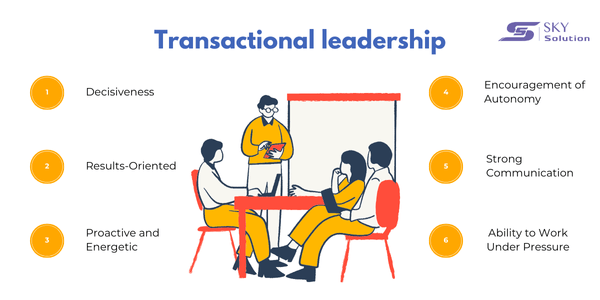Transactional leadership is increasingly relevant as today’s skilled workforce embraces the mindset of ‘Why should I work for you?’ Individuals often choose organizations based on their leaders’ characteristics.
A strong leader inspires the team, maintains a long-term vision, adapts to change, and effectively navigates challenges. Leaders can be categorized by their approach, with transactional leadership being a key style. Sky Solution will provide insights into this influential leadership model.
I. What is Transactional Leadership?
Transactional leadership emphasizes achieving results through direct and decisive actions. Leaders typically focus on goals and continuously seek ways to improve performance and achieve success for their organizations. They ensure that tasks run smoothly by collaborating with or delegating to others.
Here are some key characteristics of transactional leadership:
- Decisiveness: Leaders make quick decisions based on available information and their personal experience. They are not afraid of mistakes and are willing to accept reasonable risks to achieve their goals.
- Results-Oriented: Their ultimate aim is to achieve specific outcomes. They highly value staff performance and regularly monitor progress to ensure that projects are on track.
- Proactive and Energetic: They are characterized by dynamism and a readiness to take action. They frequently engage in projects and strive to overcome obstacles.
- Encouragement of Autonomy: While they prefer to control and guide the workflow, they also encourage employees to solve problems independently, creating an open and creative work environment.
- Strong Communication: They possess the ability to communicate clearly and effectively, ensuring that everyone understands the goals and actions needed to achieve success.
- Ability to Work Under Pressure: They often perform best in urgent situations or when faced with significant challenges, where decisiveness and quick action are necessary.

II. When Should You Apply Transactional Leadership?
Transactional leadership is particularly suited to jobs and objectives that require speed, flexibility, and decisiveness, including:
- Startups and New Businesses: Quickly adjusting strategies, accelerating product development, and driving growth.
- Projects with Tight Deadlines: Work that requires substantial resources and efforts to achieve objectives, ensuring that project timelines are met.
- Crisis Situations or Highly Competitive Environments: Making swift decisions and implementing decisive measures to address problems, thereby creating competitive advantages and seeking opportunities to enhance the company’s standing.
- Product Development and Innovation: Rapidly learning from failures and drawing on experiences to swiftly adapt and improve products.
III. A Lesson from Elon Musk’s Case
A notable example of transactional leadership in practice is Elon Musk, CEO of SpaceX and Tesla. Musk is renowned for his leadership style characterized by decisiveness, boldness, and a relentless push for innovation. He has demonstrated himself as a transactional leader not only by setting ambitious goals, such as sending humans to Mars and revolutionizing the automotive industry with electric vehicles, but also by vigorously driving the development and implementation of new technologies. Musk is unafraid of failure; instead, he views failure as an important step toward achieving ultimate success. This is evidenced by the series of unsuccessful rocket launches by SpaceX before they ultimately succeeded in launching the Falcon 1 into orbit, marking a new era for private space travel.

In managing Tesla, Musk accelerated production processes and product development, overcoming significant financial and production challenges to make Tesla the world’s leading electric vehicle manufacturer. He not only changed public perceptions of electric vehicles but also pushed the entire automotive industry toward a more sustainable direction.
His courage to face risks and his ability to quickly adapt to change are key factors contributing to Elon Musk’s success. He serves as a vivid testament to the power and effectiveness of transactional leadership, turning ideas into reality.
IV. Conclusion
In summary, transactional leadership offers a dynamic management style that strongly focuses on achieving results. Leaders who embody this style consistently concentrate on goals. They are not afraid of failure and frequently encourage employee initiative in their work. They serve as sources of inspiration and motivation for their teams. As a result, transactional leadership becomes an effective management style, helping leaders achieve success in running their businesses.

